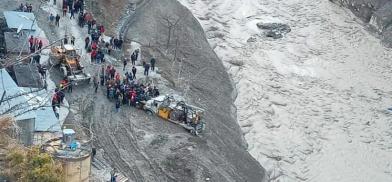Himalayan disasters: Urgent need for collaboration between India, Nepal and Bhutan
The Chamoli disaster should serve as an eye-opener for nations, government and individuals alike. In order to decrease the magnitude of such environmental disasters that occur or can occur in the coming future, it is necessary for the governments of India, Nepal, and Bhutan to collaborate in order to come up with sustainable solutions, writes Shushant V C for South Asia Monitor

The world is still reeling due to the COVID pandemic and to add to the woes of the people, many nations are experiencing environmental issues and disasters. India is no exception - the environmental disaster in the Himalayan state of Uttarakhand in February 2021.
The Uttarakhand disaster in the form of an avalanche and deluge, after a portion of the Nanda Devi glacier broke off, has clearly shown that the Himalayas is in fact very fragile by nature and therefore requires the utmost care in terms of protection and conservation as stated by institutions such as the International Centre for Integrated Mountain Development (ICIMOD), a regional intergovernmental learning and knowledge sharing centre that serves the eight regional member countries of the Hindu Kush Himalaya (HKH) countries - Afghanistan, Bangladesh, Bhutan, China, India, Myanmar, Nepal, and Pakistan.
The frightening visuals of the flood in which 54 people lost their lives and over 150 people are still missing, show that the Himalayas are vulnerable to a multitude of geological and natural processes. It also poses a grave reminder that its vulnerabilities are exacerbated by climate change. It has also triggered fear that many environmental issues and disasters of a similar scale in the Himalayan nations of Nepal and Bhutan could also take place.
Chamoli disaster: What happened and why?
Chamoli in Uttarakhand saw flash floods sweeping through its many valleys and thus bringing destruction and death to many of its inhabitants on Feb 7. The sudden flood in the middle of the day in the Dhauli Ganga, Rishi Ganga, and Alaknanda rivers - all intricately linked tributaries of the Ganga - triggered widespread panic and large-scale devastation in the high mountain areas. The flash floods also damaged the hydropower project, Tapovan Vishnugad Hydropower Project, and the Rishi Ganga Hydropower Project. Many experts had initially thought that the Chamoli flash floods might have been caused by a Glacial Lake Outburst Flood (GLOF). A GLOF is a type of flood that occurs when there is melting of ice in a glacier. Due to the excessive melting of the glacial ice, a glacial lake is created which over a period of time increases in size. This glacial lake turns into a GLOF when the barrier that is holding the glacial lake in place becomes thin due to a plethora of reasons such as erosion, increase in water pressure, avalanche, etc., which in turn makes the glacial lake burst forth and cause floods in the regions surrounding the glacier.
As the analysis was being carried out, it became more and more clear that GLOF was not the reason for the floods.
ICIMOD in its recent report has stated that the flash floods in Chamoli, Uttarakhand have not been triggered by a GLOF as there is no glaciers in the immediate vicinity of the area where the floods have occurred. In fact, they believe the floods were caused due to a rockslide that took place below Ronti peak which generated enough energy to have melted the ice in the area that resulted in the flash floods. Another reason stated by the report is a change in the weather activity that
further increased the extent of the floods.
Implications for Himalayan region
The destruction caused by the Chamoli disaster has wide-ranging implications for the entire Himalayan region. Nations like Nepal and Bhutan have a high probability of such events occurring within their territories. Many experts have stated that both Nepal and Bhutan can see a rise in outbursts of floods in the coming years due to the many changes induced by climate change. Scientific literature that is available predicts that both the Himalayan nations are bearing the brunt of climate change and its effects and these in turn only increase the occurrence of such an event in both nations in the times to come.
Reports generated by ICIMOD and UNDP (United Nations Development Programme) have clearly marked the presence of 47 glacial lakes in the regions surrounding India, Nepal, and Tibet out of which 21 glacial lakes are in Nepal itself. In another report by ICIMOD, 14 GLOF related events have occurred in Nepal. The ICIMOD has also stated that though the glaciers provide important water storage, but when warming across the globe is accelerated, there are changes in water flows and risks of glacial lake outburst events occuring.
Like Nepal, Bhutan too has the likelihood of witnessing such an event occur within its boundaries. Experts have suggested that since Bhutan is heavily dependent upon hydropower projects for wealth and electricity generation, therefore such a disaster will cripple the Bhutanese nation on many levels. There are 17 potentially dangerous glacial lakes in Bhutan, as identified by the Bhutanese government that can destroy many important hydropower projects which are the lifelines of the nation.
Lessons from the disaster
The Chamoli disaster should serve as an eye-opener for nations, governments, and individuals alike. In order to decrease the magnitude of such environmental disasters that occur or can occur in the coming future, it is necessary for the governments of India, Nepal, and Bhutan to collaborate in order to come up with sustainable solutions.
The installation of Early Warning Systems (EWS) and comprehensive monitoring of the fragile ecosystem prevalent in the Himalayan region is of utmost importance. Cooperation with experts will help further in decreasing the impact of environmental disasters.
(The writer is a Ph.D. in political science from Amity University, India. The views are personal. He can be contacted at simmaksushant@gmail.com)









Post a Comment